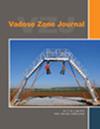生物孔涂层土块的水力机械孔隙尺度耦合建模,用于提升土壤收缩率和水力特性
IF 2.8
3区 地球科学
Q3 ENVIRONMENTAL SCIENCES
引用次数: 0
摘要
蚯蚓和植物根系对大孔隙的形成和稳定至关重要。生物孔表面的有机矿物涂层还能在优先流动过程中调节大孔与基质之间的质量交换。通过放大孔隙尺度的水力和力学模拟,可以评估收缩过程中质地更细的孔穴涂层对土壤宏观特性的影响。目的是研究微观参数(粒度、硬度和粘结强度)对宏观参数(即收缩曲线和土壤水力特性)的影响。使用有生物孔涂层和无涂层的泥块大小样本进行了排水实验和模拟。模拟使用了两相孔隙尺度有限体积与离散元素耦合模型(DEM-2PFV)。通过分析从数值测定数据中获得的孔隙体积和土壤收缩曲线,对结构动力学进行了表征。土壤水力参数使用单峰和双峰 van Genuchten(vG)函数进行描述。排水模拟揭示了以布劳德收缩曲线子域为特征的水力学动态:纯基质样品的颗粒结合强度较低,收缩率相对较高。而具有较高颗粒刚度和粘结强度的涂层样品则表现出更高的水力学稳定性。通过数值确定的饱和水导率初始值(Ks),纯基质样品比涂层样品大 70 倍左右。正如预期的那样,对于非刚性土壤结构,双峰 vG 模型的 Ks、α 和 n 值恒定会导致预测误差。将 DEM-2PFV 孔隙尺度模型结果放大,可量化微涂层对宏观水力学的影响。这就产生了基于空隙率的土壤水分保持率和水力传导函数,从而推进了宏观土壤水力模型的发展,并增强了结构化土壤流动和传输描述。本文章由计算机程序翻译,如有差异,请以英文原文为准。
Coupled hydro‐mechanical pore‐scale modeling of biopore‐coated clods for upscaling soil shrinkage and hydraulic properties
Earthworms and plant roots are vital for macropore formation and stabilization. The organo‐mineral coating of biopore surfaces also regulates macropore‐matrix mass exchange during preferential flow. The influence of finer‐textured burrow coatings on macroscopic soil properties during shrinkage could potentially be assessed by upscaling pore‐scale hydraulic and mechanical simulations. The aim was to investigate the influence of micro parameters (particle size, stiffness, and bond strength) on macro parameters (i.e., shrinkage curve and soil hydraulic properties). Drainage experiments and simulations were carried out using biopore‐coated clod‐size samples compared to those without coating. Simulations were performed using a two‐phase pore‐scale finite volume coupled with discrete element model (DEM‐2PFV). The structural dynamics was characterized by analyzing the pore volume and soil shrinkage curve obtained from numerically determined data. The soil hydraulic parameters were described using uni‐ and bimodal van Genuchten (vG) functions. The drainage simulations revealed hydro‐mechanical dynamics characterized by Braudeau‐shrinkage curve subdomains: The matrix‐only samples, with lower particle bond strength, exhibited relatively higher shrinkage. The coated samples, with higher particle stiffness and bond strength, displayed greater hydro‐mechanical stability. The numerically determined initial value of the saturated hydraulic conductivity (Ks ) was about 70 times larger for matrix‐only samples than for coated samples. As expected, for the nonrigid soil structures, constant Ks , α , and n values for bimodal vG model resulted in prediction errors. Upscaling DEM‐2PFV pore‐scale model outcomes quantifies micro‐coating effects on macro hydro‐mechanics. This yields void ratio‐based soil water retention and hydraulic conductivity functions, advancing macroscopic soil hydraulic models and enhancing structured soil flow and transport descriptions.
求助全文
通过发布文献求助,成功后即可免费获取论文全文。
去求助
来源期刊

Vadose Zone Journal
环境科学-环境科学
CiteScore
5.60
自引率
7.10%
发文量
61
审稿时长
3.8 months
期刊介绍:
Vadose Zone Journal is a unique publication outlet for interdisciplinary research and assessment of the vadose zone, the portion of the Critical Zone that comprises the Earth’s critical living surface down to groundwater. It is a peer-reviewed, international journal publishing reviews, original research, and special sections across a wide range of disciplines. Vadose Zone Journal reports fundamental and applied research from disciplinary and multidisciplinary investigations, including assessment and policy analyses, of the mostly unsaturated zone between the soil surface and the groundwater table. The goal is to disseminate information to facilitate science-based decision-making and sustainable management of the vadose zone. Examples of topic areas suitable for VZJ are variably saturated fluid flow, heat and solute transport in granular and fractured media, flow processes in the capillary fringe at or near the water table, water table management, regional and global climate change impacts on the vadose zone, carbon sequestration, design and performance of waste disposal facilities, long-term stewardship of contaminated sites in the vadose zone, biogeochemical transformation processes, microbial processes in shallow and deep formations, bioremediation, and the fate and transport of radionuclides, inorganic and organic chemicals, colloids, viruses, and microorganisms. Articles in VZJ also address yet-to-be-resolved issues, such as how to quantify heterogeneity of subsurface processes and properties, and how to couple physical, chemical, and biological processes across a range of spatial scales from the molecular to the global.
 求助内容:
求助内容: 应助结果提醒方式:
应助结果提醒方式:


